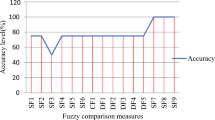Abstract
Correspondence analysis is a very common and renowned statistical technique, with applications in data summarization, classification, regression, etc. One particular approach is that of comparing different partitions over the same set of objects. Moreover, it can be interesting to analyze correspondences at different detail levels, not only between partitions, but between classes in these partitions. In addition, the case of fuzzy partitions over data is still a researching milestone in development. In this work we propose a novel measure following a previous definition of an alternate methodology in terms of data mining tools, in order to overcome some limitations of the former one for the case of considering partial and global correspondences between fuzzy partitions.
Access this chapter
Tax calculation will be finalised at checkout
Purchases are for personal use only
Similar content being viewed by others
References
Anderson, D.T., Bezdek, J.C., Keller, J.M., Popescu, M.: A comparison of five fuzzy rand indices. In: Hüllermeier, E., Kruse, R., Hoffmann, F. (eds.) IPMU 2010. CCIS, vol. 80, pp. 446–454. Springer, Heidelberg (2010). doi:10.1007/978-3-642-14055-6_46
Anderson, D.T., Bezdek, J.C., Popescu, M., Keller, J.M.: Comparing fuzzy, probabilistic, and possibilistic partitions. IEEE Trans. Fuzzy Syst. 18(5), 906–918 (2010)
Benzécri, J.: Cours de Linguistique Mathématique. Faculté des Sciences, Université de Rennes (1964)
Beringer, J., Hüllermeier, E.: Fuzzy clustering of parallel data streams. In: Advances in Fuzzy Clustering and Its Application, pp. 333–352 (2007)
Berzal, F., Blanco, I., Sánchez, D., Serrano, J., Vila, M.: A definition for fuzzy approximate dependencies. Fuzzy Sets Syst. 149(1), 105–129 (2005). Fuzzy Sets in Knowledge Discovery
Brouwer, R.K.: Extending the rand, adjusted rand and jaccard indices to fuzzy partitions. J. Intell. Inform. Syst. 32(3), 213–235 (2009)
Calero, G., Delgado, J., Serrano, J., Sánchez, D., Vila, M.: A proposal of fuzzy correspondence analysis based on flexible data mining techniques. In: Soft Methodology and Random Information Systems, pp. 447–454. Springer, Heidelberg (2004)
Campello, R.J.: A fuzzy extension of the rand index and other related indexes for clustering and classification assessment. Pattern Recogn. Lett. 28(7), 833–841 (2007)
Cox, M.A.A., Cox, T.F.: Multidimensional Scaling, pp. 315–347. Springer, Heidelberg (2008)
Delgado, M., Ruiz, M., Sánchez, D., Serrano, J.: A formal model for mining fuzzy rules using the RL representation theory. Inform. Sci. 181(23), 5194–5213 (2011)
Frigui, H., Hwang, C., Rhee, F.C.-H.: Clustering and aggregation of relational data with applications to image database categorization. Pattern Recogn. 40(11), 3053–3068 (2007)
Greenacre, M.: Correspondence Analysis in Practice, 3rd edn. CRC Press, Boca Raton (2016)
Hullermeier, E., Rifqi, M., Henzgen, S., Senge, R.: Comparing fuzzy partitions: a generalization of the rand index and related measures. IEEE Trans. Fuzzy Syst. 20(3), 546–556 (2012)
Jaccard, P.: Étude comparative de la distribution florale dans une portion des alpes et des jura. Bulletin del la Société Vaudoise des Sciences Naturelles 37, 547–579 (1901)
Meseguer Artola, A., Aibar Puentes, E., Lladós Masllorens, J., Minguillón Alfonso, J., Lerga Felip, M.: Factors that influence the teaching use of wikipedia in higher education (2014)
Molina, C., Prados, B., Ruiz, M.-D., Sánchez, D., Serrano, J.-M.: Comparing partitions by means of fuzzy data mining tools. In: Hüllermeier, E., Link, S., Fober, T., Seeger, B. (eds.) SUM 2012. LNCS (LNAI), vol. 7520, pp. 337–350. Springer, Heidelberg (2012). doi:10.1007/978-3-642-33362-0_26
Rand, W.M.: Objective criteria for the evaluation of clustering methods. J. Am. Stat. Assoc. 66(336), 846–850 (1971)
Ruspini, E.H.: A new approach to clustering. Inform. Control 15(1), 22–32 (1969)
Sánchez, D., Serrano, J.M., Vila, M.A., Aranda, V., Calero, J., Delgado, G.: Using data mining techniques to analyze correspondences between user and scientific knowledge in an agricultural environment. In: Piattini, M., Filipe, J., Braz, J. (eds.) Enterprise Information Systems IV, pp. 75–89. Kluwer Academic Publishers, Hingham (2003)
Shortliffe, E., Buchanan, B.: A model of inexact reasoning in medicine. Math. Biosci. 23, 351–379 (1975)
Acknowledgements
This work has been partially supported by the Spanish Ministry of Economy and Competitiveness and the European Regional Development Fund (FEDER) under projects TIN2015-64776-C3-1-R and TIN2014-58227-P, and by the Energy IN TIME project funded from the European Union in the Seventh Framework Programme under grant agreement No. 608981.
Author information
Authors and Affiliations
Corresponding author
Editor information
Editors and Affiliations
Rights and permissions
Copyright information
© 2017 Springer International Publishing AG
About this paper
Cite this paper
Molina, C., Ruiz, M.D., Sánchez, D., Serrano, J.M. (2017). Ad Hoc Metric for Correspondence Analysis Between Fuzzy Partitions. In: Moral, S., Pivert, O., Sánchez, D., Marín, N. (eds) Scalable Uncertainty Management. SUM 2017. Lecture Notes in Computer Science(), vol 10564. Springer, Cham. https://doi.org/10.1007/978-3-319-67582-4_31
Download citation
DOI: https://doi.org/10.1007/978-3-319-67582-4_31
Published:
Publisher Name: Springer, Cham
Print ISBN: 978-3-319-67581-7
Online ISBN: 978-3-319-67582-4
eBook Packages: Computer ScienceComputer Science (R0)




